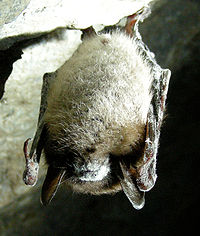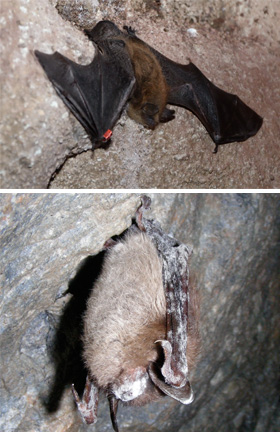Bat Removal and Exclusion MN
Minnesota has seven species of Bats. Out of the seven species of bats that we have in our area, three are tree dwellers and have little or no interaction with man. The other four species of bats found in Minnesota are cave dwellers. The two species of bats that cause the majority of problems in Minnesota are the Large or Big Brown bat (Eptesicus fuscus), and the Little Brown bat (Myotis lucifugus). Unfortunately our homes appear to a bat as a large, convenient cave.
Alarmingly, bats are disappearing worldwide. They are now considered the most endangered land mammal in North America due to White nose Syndrome (WNS). A fungus that has killed off about 90 percent of the state’s bat population. The disease was first discovered in a commercial cave in New York state in 2006. This cave was frequently visited by tourists, which is why scientists believe that humans carried the first fungal spores into the cave.
All of the bats affected by WNS in other states have been insect eaters that hibernate. All four of the bat species that hibernate in Minnesota—little brown myotis, northern myotis, tricolored bat, and big brown bat—have been affected by WNS in the East, although big browns to a lesser extent. Little browns, Minnesota’s most common bat, are the hardest hit, suffering 99 to 100 percent mortality where WNS strikes.
A study of the little brown bat projected the species would be essentially extinct in the Northeast by 2026.
We Need Our Bats!
Losing bats would have devastating consequences for natural ecosystems and human economies. In Minnesota and the surrounding states, bats are an important part of our ecology. A single bat can eat up to 3,000 mosquitoes and other flying insects in one night and an average size colony can eat up to a half million insects every night!
A single female bat can eat up to her body weight in insects every night. That’s equal to a 200-pound man eating 800 quarter-pound cheese burgers in a single night!
And since many of the insects eaten by bats are crop pests, losing large numbers of bats could lead to agricultural losses estimated at more than $3.7 billion/year.
Bat Exclusion
There are ways to remove bats without killing them. Once you know there is a bat colony, the best way to bat proof your house is through exclusion. It is a safe, effective, and humane way of evicting unwanted bats. Exclusion takes into account the well-being of both the people getting rid of the bat and the bat itself. No poison or other harmful chemicals are used.
It is very important that proper inspection techniques and exclusion methods be utilized. If not, you could end up with numerous adult and/or young bats being closed in your walls, eves, or attic, causing a large sanitation problem from dead bats or even having bats come out into your house with you and your family.
Excluding Bats completely from a building may be accomplished by closing up openings in walls, eaves, and roofs after you are sure all of the Bats are gone.
Exclusion should NOT be performed when young bats, incapable of flying, are present (typically May-July). This should not be done in the Spring because newborn bats will be trapped. Bat exclusions should be performed ONLY during the months of August and September!
Note: Never trap flightless young or adult bats inside a structure; this is needlessly cruel to the bats inside and can create a serious odor or pest problem.
A Minnesota Wild Animal Control Company experienced in excluding bats can be hired, or you can do the exclusion work yourself. In attics and areas where large numbers of bats have been roosting for years, it is safer for you to hire a professional to do the work, including the cleanup of accumulated droppings, along with prevention services to keep bats out for good.





